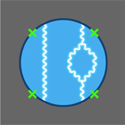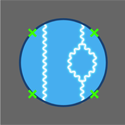Combining two approaches to the strong force
Quantum Chromodynamics (QCD) is the fundamental description of the strong force in the standard model of particle physics. QCD is very successful at describing the behavior of quarks and gluons at high energies. However, at energies below about , the theory becomes strongly coupled, and one must account for bound states of the theory: pions, protons, neutrons, and other hadrons. Attempts to formulate an effective theory of strong interactions at such low energies have traditionally suffered from problems of renormalizability, which severely constrain their predictive powers.
One approach that has been used involves “constituent quarks,” which dress up the bare quarks of QCD into effective entities. For example, a proton is often described as being “composed of three constituent quarks.” A second approach is to make an expansion in the limit of “large ” where is the number of colors. Although is only in QCD, this approach often works well qualitatively. Now, in a recent paper in Physical Review Letters, Steven Weinberg proposes a way to marry the two approaches into an effective field theory of constituent quarks, gluons, and pions. It turns out that the large limit of this effective theory is renormalizable.
This proposal introduces a new computational tool for hadronic physics and investigations of its phenomenological viability are likely to launch interesting future research. – Abhishek Agarwal and Robert Garisto





